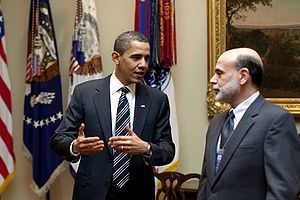| English: President Barack Obama confers with Federal Reserve Chairman Ben Bernanke following their meeting at the White House. (Photo credit: Wikipedia) |
Washington, Feb.21, stock trade .- The The Federal Reserve signaled it may consider slowing the pace of asset purchases as officials extended a debate over whether record monetary easing risks unleashing inflation or fueling asset-price bubbles.
Several participants at the Federal Open Market Committee’s Jan. 29-30 meeting “emphasized that the committee should be prepared to vary the pace of asset purchases, either in response to changes in the economic outlook or as its evaluation of the efficacy and costs of such purchases evolved,” according to the minutes of the gathering released yesterday. Stocks fell, along with oil and gold, on bets the central bank will curb stimulus earlier than expected, even as several Fed officials warned against a premature end to $85 billion in monthly bond buying. A gradual reduction in purchases may win the FOMC’s support because it gives policy makers flexibility, said Michael Hanson, senior U.S. economist at Bank of America Corp. in New York.
The minutes show “tapering is a likely outcome at some point in the future,” said Hanson, a former Fed economist. “If you taper the purchases, it allows you to calibrate how the market reacts to your actions without having to go cold turkey.”
Policy makers in December started debating when to halt bond buying that has pushed the Fed’s assets to more than $3 trillion, prompting warnings by some officials that the program will complicate an eventual withdrawal of stimulus.
‘Evenly Divided’
At the December meeting, Fed officials were “approximately evenly divided” between those favoring a mid-2013 end to purchases and those advocating a later date, according to minutes from the gathering. Chairman Ben S. Bernanke has pledged to buy bonds until there’s a “substantial” improvement in a labor market burdened by 7.9 percent unemployment.
The minutes released yesterday didn’t indicate a discussion about when to end quantitative easing.
“They’re changing the debate toward when to scale it down rather than debating the point where it suddenly ends,” said Jim O’Sullivan, chief U.S. economist at High Frequency Economics in Valhalla, New York. “With the economy looking more solid than they feared a few months ago, financial-sector risks take on more importance.”
The Standard & Poor’s 500 Index fell more yesterday than in any trading session since November, declining 1.2 percent to 1,511.95. The index is up 6 percent this year. The yield on the 10-year Treasury note fell to 2.01 percent from 2.03 percent on Feb. 19.
Total Size
The FOMC at its January meeting decided to continue buying $45 billion a month of Treasuries and $40 billion in mortgage debt without setting a limit on the duration or total size of the purchases. Policy makers also affirmed their pledge to keep the target interest rate near zero “at least as long” as unemployment remains above 6.5 percent and inflation is projected to be no more than 2.5 percent.
A number of officials said that their evaluation of costs and benefits of the policy “might well lead the Committee to taper or end its purchases before it judged that a substantial improvement in the outlook for the labor market had occurred,” according to the minutes.
“Several others argued that the potential costs of reducing or ending asset purchases too soon were also significant, or that asset purchases should continue until a substantial improvement in the labor-market outlook had occurred,” the minutes showed. The minutes don’t give the names of officials or specify the precise number holding a given view.
New Ways
The minutes said that the committee would conduct a review of quantitative easing at the March 19-20 meeting. Fed officials are also considering new ways to present economic projections in their public communications. Many participants expressed interest in using their quarterly projections to convey information about future asset purchases and the Fed’s balance sheet.
With inflation below their long-term goal of 2 percent, policy makers are forging ahead with record accommodation to stoke an economy that shrank 0.1 percent last quarter. The Fed has pushed the benchmark interest rate close to zero and expanded its balance sheet to more than $3 trillion.
The minutes said “many participants” expressed concern about “potential costs and risks arising from further asset purchases.” Several discussed “possible complications” that additional purchases could have as the Fed begins to exit the policy, a few mentioned inflation risks, and some mentioned risks to financial stability.
Capital Losses
“Several participants noted that a very large portfolio of long-duration assets would, under certain circumstances, expose the Federal Reserve to significant capital losses when these holdings were unwound,” the minutes said. “Others pointed to offsetting factors, and one noted that losses would not impede the effective operation of monetary policy.”
Bernanke is waiting to see improvement in employment and is not yet too concerned with the costs, former Minneapolis Fed President Gary Stern said yesterday in a Bloomberg Radio interview on “The Hays Advantage” with Kathleen Hays.
The Fed chairman and his “principal allies” remain “concerned about the economic outlook,” Stern said. ...

No comments:
Post a Comment